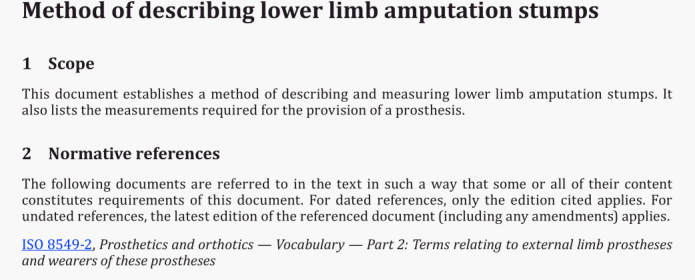Prosthetics and orthotics

BS ISO 8548-2:2020 pdf free.Prosthetics and orthotics – Limb deficiencies Part 2: Method of describing lower limb amputation stumps.
The following documents are referred to in the text in such a way that some or all of their content constitutes requirements of this document. For dated references, only the edition cited applies. For undated references, the latest edition of the referenced document (including any amendments) applies.
ISO 8549-2. Prosthetics and orthotics — Vocabulary — Part 2: Terms relating to external limb prostheses and wearers of these prostheses
ISO 8549-4, Prosthetics and orthotics — Vocabulary — Part 4: Terms relating to limb amputation
3 Terms and definitions
For the purposes of this document, the terms and definitions given in ISO 8549-2 and ISO 8549-4 apply.
ISO and IEC maintain terminological databases for use in standardization at the following addresses:
— ISO Online browsing platform: available at https://www.iso.org/obp
— IEC Electropedia: available at http://www.electropedia.org/
4 Stump description
4.1 General
Specify the amputation side and describe the stump using the relevant descriptors listed in the appropriate tables (Tables 1 to 7) and the guidance given in 42 to 4J.
4.2 Stump characteristics
The shape of the stump should be described as either conical, bulbous or cylindrical. In this context, the meanings of these terms are self-evident.
The soft tissues of the stump should be described by reference to their amount and consistency. The amount should be described as sufficient, insufficient or excessive and the consistency described as normal, flabby or indurated. If the heel pad is retained, its position should be recorded as correctly positioned, displaced or mobile.
It is important to record whether the stump musculature is attached, detached or displaced.
Relevant bony features such as prominences, remnants, length or position should be described. The presence of any prominent foreign bodies, for example grafts, implants or shrapnel, should be noted.
4.7.4 JoInt pain
Pain in the proximal joint(s) should be recorded.
5 Measurement of lower limb amputation stumps
5.1 Reference levels and reference planes
5.1.1 General
Identify the reference levels and planes relevant to the particular level of amputation as described in 12 and .L3.
5.1.2 Reference levels
5.1.2.1 Waist
The level midway between the costal margin and the iliac crest.
5.1.2.2 Iliac crest
The level defined by a line joining the highest point on the crest of each ilium.
5.1.2.3 Proximal
The most proximal level at which a circumferential measurement, perpendicular to the mid-line of the thigh, can be obtained.
5.1.2.4 Minimum circumferential
In knee and ankle disarticulation stumps only, the level of the minimum circumference.
5.1.2.5 Femoral condylar
In knee disarticulation and transcondylar amputation stumps only, the level of the maximum condylar circumference.
5.1.2.6 Inflection
In transfemoral and transtibial stumps only, the level on the stump at which the slope of the stump shape changes as it curves in towards the end.
5.1.2.7 Stump end
The level of the stump end.
5.1.2.8 MedIal joint line
The level of the medial tibial plateau, unless there is a fixed deformity of the knee, in which case this level is the highest at which a circumferential measurement perpendicular to the mid-line of the stump can be obtained.
5.1.2.9 Mid-patellar tendon
The level mid-way between the origin and insertion of the patellar tendon.
5.1.2.10 Malleolar
In ankle disarticulation stumps only, the level of the maximum distal circumference.
5.1.2.11 Ground
The level on which the patient is standing barefoot.
5.1.3 Reference planes used for partial foot amputations
5.1.3.1 Heel
The plane at the posterior aspect of the heel parallel with the mid-line of the leg.
5.1.3.2 Anterior tibial
The plane at the anterior aspect of the tibia at the ankle joint line parallel with the mid-line of the leg.
5.1.3.3 Stump end
The plane at the stump end parallel with the mid-line of the leg.
5.1.3.4 Toe
The plane at the tips of the toes of the contralateral leg parallel with the mid-line of the leg.
5.2 Measurements
This document does not specify the method to be used to obtain the measurements. It specifies both the measurements which should be taken by the team responsible for the rehabilitation of the person and those to be taken only by the prosthetist responsible for the provision of a prosthesis.
In order that the description of the stump can be related to the person as a whole, the contralateral limb needs some minimal measurement.
Measure and record the length, circumferential, width and antero-posterior measurements as specified in Table Band illustrated in Figures ito for the level of amputation.
The posture of the person in which the measurements are taken should be recorded.BS ISO 8548-2 pdf free download.Prosthetics and orthotics